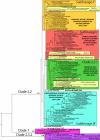H5N1 Virus Evolution in Europe-An Updated Overview
- PMID: 21994596
- PMCID: PMC3185504
- DOI: 10.3390/v1031351
H5N1 Virus Evolution in Europe-An Updated Overview
Abstract
Since its emergence in South East Asia in 2003, Highly Pathogenic Avian Influenza (HPAI) A/H5N1 has reportedly caused outbreaks in poultry and/or wild birds in 62 countries, of which 24 were in Europe. Interestingly, out of the many genetic clades circulating in Asia, the westward spread of HPAI A/H5N1 to Central Asia, the Middle East, Europe and Africa was dominated by one single clade, namely clade 2.2. In this paper, we review and update through phylogenetic and gene migrational analysis the information concerning the evolution and the molecular epidemiology of HPAI A/H5N1 on the European continent.
Keywords: Europe; H5N1; avian influenza.
Figures

References
-
- Xu X, Subbarao K, Cox NJ, Guo Y. Genetic characterization of the pathogenic influenza A/Goose/Guangdong/1/96 (H5N1) virus: similarity of its hemagglutinin gene to those of H5N1 viruses from the 1997 outbreaks in Hong Kong. Virology. 1999;261:15–19. - PubMed
-
- Capua I, Alexander DJ. Avian influenza and human health. Acta Trop. 2002;83:1–6. - PubMed
-
- Sims LD, Brown IH. In: Avian Influenza. Swayne DE, editor. Blackwell Publishing Professional; Ames, Iowa, USA: 2008. pp. 251–286. Chapter 11.
-
- World Health Organization. H5N1 avian influenza: timeline of major events. Available online: http://www.who.int/csr/disease/avian_influenza/ai_timeline/en/index.html (accessed 27 August 2009)
-
- Guan Y, Smith GJ, Webby R, Webster RG. Molecular epidemiology of H5N1 avian influenza. Rev Sci Tech. 2009;28:39–47. - PubMed
LinkOut - more resources
Full Text Sources

